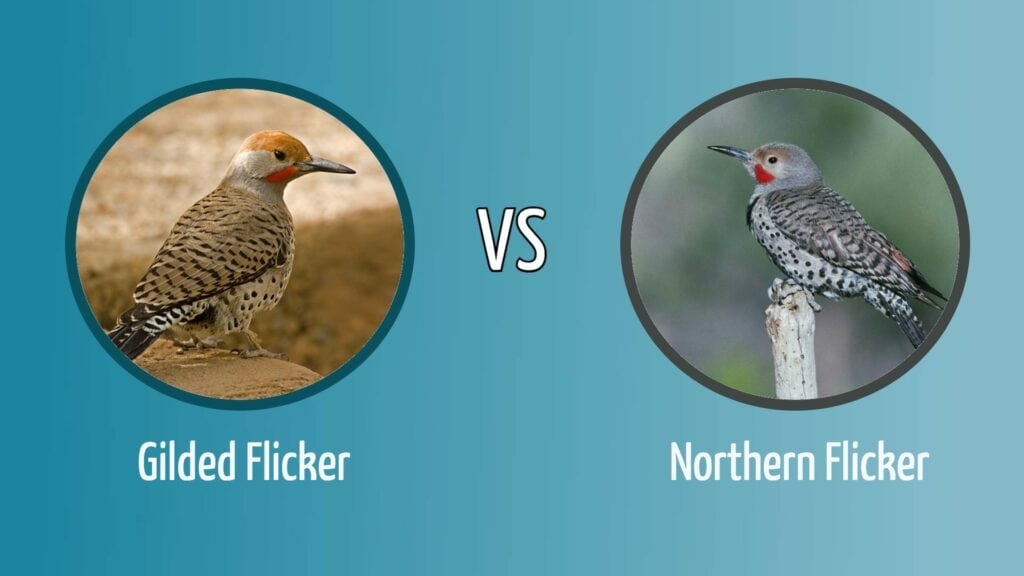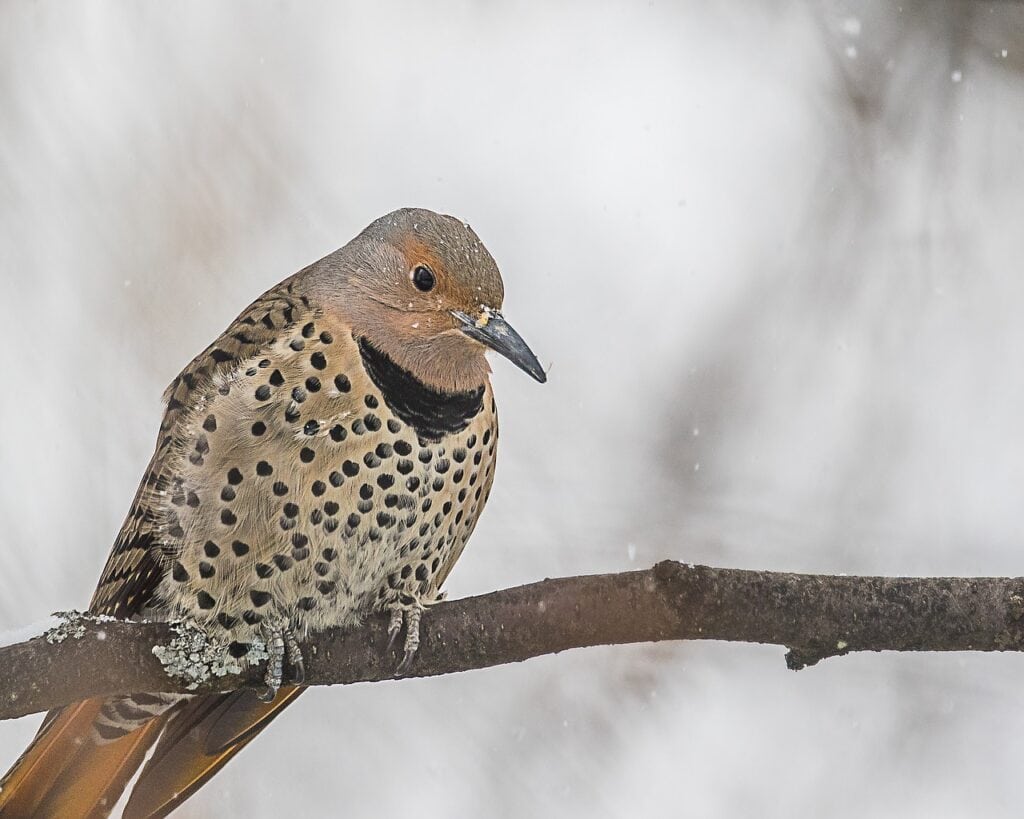Gilded Flicker Vs. Northern Flicker: The Main Differences
Last Updated on

The Gilded Flicker and the Northern Flicker are two woodpecker species that are closely related and similar in appearance. In regions where they both live, it may be nearly impossible to distinguish between them from a distance. However, at a closer glance, you’ll see that the Gilded Flicker is smaller than the Northern Flicker. It also has yellow feathers under its wings, whereas the Northern Flicker’s feathers are red underneath in the regions where their habitats overlap. Read on to learn more about the unique and shared traits of both beautiful bird species, as well as how to spot them.

Visual Differences

At a Glance
- Scientific Name: Colaptes chrysoides
- Origin: North America
- Wingspan: 7”-20.5”
- Lifespan: 6 years
- Scientific Name: Colaptes auratus
- Origin: North America
- Wingspan: 5”-20.1”
- Lifespan: 8-9 years

Gilded Flicker Overview
Characteristics & Appearance
The Gilded Flicker has bright yellow feathers under its wings, which usually have brown and white stripes. Its creamy beige chest is dappled with black circles outlined in white, and males have a triangular black patch in the center. Its body weighs slightly less than the Northern Flicker, although its wingspan is marginally wider.
Gilded Flickers share most common traits between the genders, but only males have the triangular patch on their chests and a bright red marking just under their cheek that looks like a spot of rouge. Females are similarly sized, but their feathers are a bit more muted.
If the bug population is plentiful, Gilded Flickers will mostly eat insects, especially ants that they pluck out of underground beds with their thick, sharp bill.

Habitat
Unlike most woodpeckers which live and hunt in trees, the Gilded Flicker prefers to nest on giant cacti. This resourceful bird snacks on the seeds from these succulents during the winter months when insects are scarce.
The Gilded Flicker’s habitat range is much smaller than the Northern Flicker, whose domain spans nearly the entire continent. The Gilded Flicker mostly resides in the vicinity of the Sonoran Desert in Arizona, although it’ll venture south into Mexico or west into California to a limited extent.

Northern Flicker Overview
Characteristics & Appearance
There are two types of Northern Flickers: red-shafted and yellow-shafted. Since the yellow-shafted Northern Flicker startlingly resembles the Gilded Flicker, it’s a good thing for birdwatchers that they inhabit opposite sides of the continent. Both have brown-white stripes on their backs with beige-gray chests that are dappled with black spots highlighted in white.
Both genders are the same size, but males have more color in their feathers. Red-shafted males have rouge-colored cheeks like the Gilded Flicker with a black stripe on their cheek that resembles a handlebar mustache. Yellow-shafted males have a red patch on the back of their necks instead of their cheeks, and their colors are a little more muted overall.
Female red-shafted Northern Flickers are the most distinct of all the types. Their faces are noticeably narrower than their male counterparts, making them almost look like a separate species. Their facial feathers are completely brownish gray, as opposed to the apricot coloring in the facial feathers of yellow-shafted females.

Habitat
As a whole species, the Northern Flicker resides year-round all across the U.S., including Arizona where its boundaries overlap with the Gilded Flicker. The yellow-shafted Northern Flicker mostly lives in the eastern United States, while the red-shafted Northern Flicker lives in the west. There’s a non-breeding population of Northern Flickers in California and Texas. They travel during the spring and summer to Canada to breed but return to the U.S. to spend winter in a milder climate.
Like most woodpeckers, the Northern Flicker likes to nest in holes in trees. Their loud drumming can be heard nearly half a mile away, but the Northern Flicker isn’t always looking for food in the bark. They actually like to eat insects off the ground, just like the Gilded Flicker. During the winter, they are known to feast on whatever is available, whether that’s a few sparse insects or a vegetarian fare of berries and seeds.

What Are the Differences Between the Gilded Flicker & The Northern Flicker?
Both species look similar in appearance. Although the Northern Flicker can have yellow feathers under their wings just like the Gilded Flicker, this is only true in the regions where the Gilded Flicker doesn’t live. In the west, the Northern Flicker has red under its wings, hence the name “red-shafted.” Since the Gilded Flicker only lives in the west, you can tell them apart by this variance under their wings.
Although Gilded Flickers and Northern Flickers technically inhabit the same region, they’re not necessarily in the same place at the same time. Gilded Flickers prefer to reside in cacti in the secluded desert, while the Northern Flicker is perfectly content in a tree cavity and isn’t as bothered by nearby human dwellings.
The Northern Flicker is a species of low concern, but the Gilded Flicker is actually in trouble. The species is declining due to loss of habitat as the Sonoran Desert becomes more developed for human use. It’s also estimated that the Gilded Flicker doesn’t live as long as the Northern Flicker since the oldest one recorded was only 6 years old, compared with a 9-year record of the Northern Flicker. However, this could be due to relatively limited data on the Gilded Flicker.

Conclusion
If you live in the East, you can know for sure that you’re seeing a yellow-shafted Northern Flicker instead of the desert-dwelling Gilded Flicker or the red-shafted Northern Flicker that lives out west. If you’re in California, Arizona, or Mexico, you might have to look a little closer and notice your surroundings. Gilded Flickers prefer to nest in cacti in the desert, as opposed to the tree-dwelling Northern Flicker that isn’t as likely to be bothered by your presence. You can also tell the difference by noting the color under their wings. The red-shafted Northern Flickers that inhabit the same territory as the Gilded Flicker will have red feathers under their wings, while the Gilded Flicker’s under feathers are canary yellow.
Featured Image Credit: (L) Harold Stiver, Shutterstock (R) JumpStory
About the Author Brooke Bundy
Brooke Bundy is a freelance writer who lives with three cats and a dog. She attended the University of North Georgia where she acquired a B.S. in Media Studies. Booke loves storytelling and spending time with her pets at their house in New Orleans, Louisiana. In her free time, she enjoys gardening, cooking, and brewing coffee.
Related Articles:
How to Clean a Refractor Telescope: Step-by-Step Guide
How to Clean a Telescope Eyepiece: Step-by-Step Guide
How to Clean a Rifle Scope: 8 Expert Tips
Monocular vs Telescope: Differences Explained (With Pictures)
What Is a Monocular Used For? 8 Common Functions
How to Clean a Telescope Mirror: 8 Expert Tips
Brightfield vs Phase Contrast Microscopy: The Differences Explained
SkyCamHD Drone Review: Pros, Cons, FAQ, & Verdict
